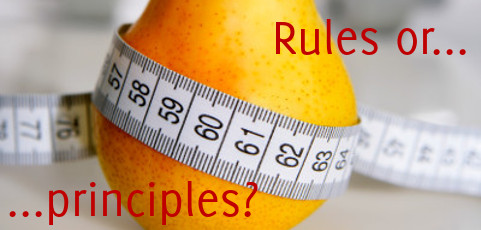The question is: do we need good rules to create effective presentations or is it better to follow more general principles? It popped to my mind after receiving a link to this post by Scott Schwertly who does a job like mine (and he’s good). To be honest the email was more drastic than the post itself:
There’s one simple premise which should be the foundation of any presentation: entrepreneur Guy Kawasaki‘s 10-20-30 PowerPoint Rule.
I love Guy’s work as much as Scott but I was hit by the mandatory statement and that prompted my question. The 10-20-30 is a good rule per se, but should it be the guideline for any presentation?
I don’t think so. Let’s put aside that given rule and the blog post on Slideshare, which is not so categorical by the way. Are rules good for designing a presentation? I am not so sure. And here is why.
As a public speaking coach and trainer since the mid ’90s I remember suggesting rules that now I find not so good any-more. One had been use bullet points list, rather than plain text, ten years later I was advocating steering away from bullet points. Time and habits changed the rule.
I had been very assertive on “how many slides per minute do you have? No more than 2 or 3.” but then I discovered the “Lessig method” and that showed me that a different approach rendered meaningless the rule.
“Never put on screen the same words you are saying”, another rule. Sometime it works, again the Lessig speech is a good example.
What is interesting is that the rule may fail over time or circumstances but the principle behind holds true. The idea behind using bullet points was to have less text on the visual aids. And that still applies. No more than 3 slide per minute is about not overloading your audience with too much information. Lessig violate the rule but not the principle.
So the key is to focus on the guiding principles that always should inspire your presentation design and delivery. I believe the following ones will never get you wrong.
- The audience is king. The presentation is for them, not about you.
- There’s a limited amount of information we can absorb at a time.
- We are visual animals.
- Decision are taken both on logical and emotional stimulus.
- Be yourself. Be sincere. Be human.
Of course the list could be expanded more but to me those are great guidelines that we should never forget or overlook. From those we can infer then many practical rules. As an example the first one should remind us to speak the language of the public and use references and examples that will resonate with who they are. The second one has many implications like less is better, avoid complicated jargon, and no more than one message per presentation and one concept per slide. The third one is about using visual aids or a picture is worth thousand words and so on.
To conclude I would say that rules can be OK and an easy way to incorporate good practices in your presentation. But remember they don’t work always and they are much more effective when you fully grasp the principles behind them.


Recent Comments